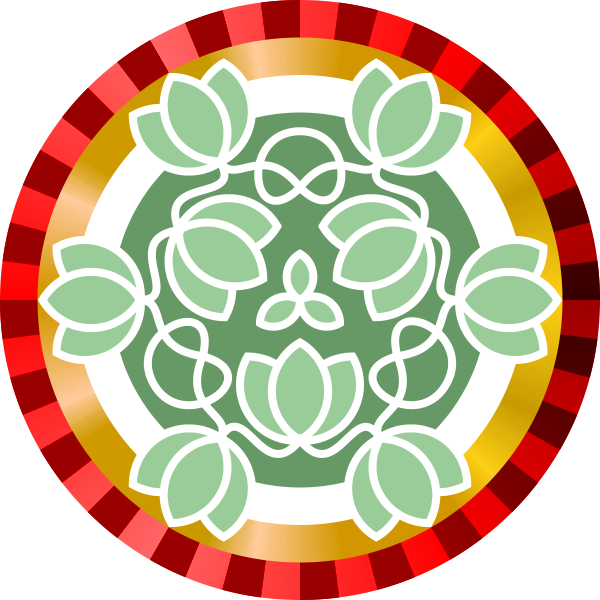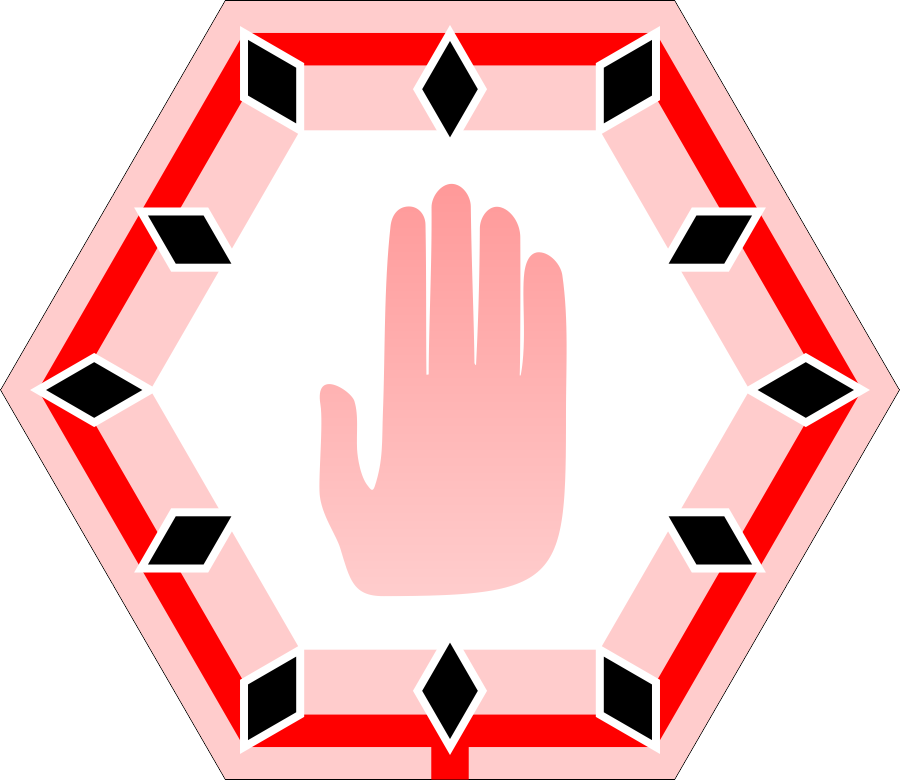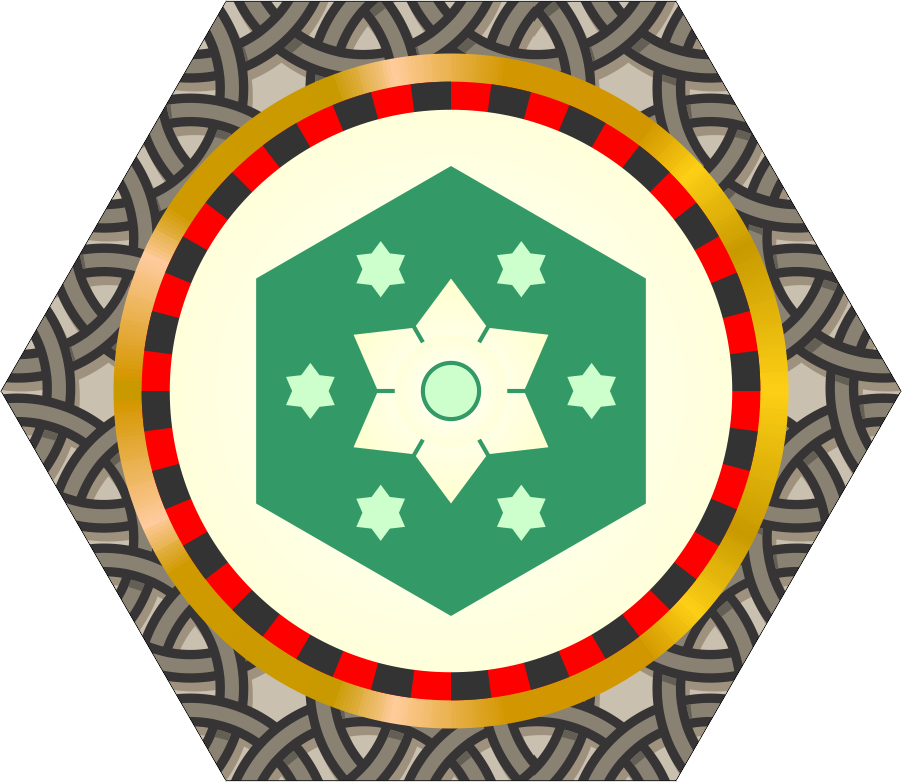Vyozha
Vyozha (pronounced vyo-ʒa) is card game with elements dating all the way back to the time of the Old Voxelian peoples, before they split into New Voxelians and Elovisians. Equal parts card game and divinatory practice, vyozha is an important staple of ritual devotions to the goddess Lyvianne (of the Unexpector faith), though it also sees recreational play in pubs and gambling halls throughout the Manifold.
History
The imagery of vyozha has roots in Old Voxelian culture, from a time before the exile of the Elovisian peoples and before Sokalyx the Learned unified the various folk traditions of the Medial A cube cultures in the Incunabula of the House of the Unexpected. This early tradition is the source of the simplified symbols on non-sacred vyozha decks, as, otherwise, no modern New Voxelian would recognize them as representing the member deities of the House of the Unexpected. Early vyozha probably had a more limited ruleset than the modern variant, as the use of multiples and factors was likely too advanced for pre-literate cultures to grasp from verbal rules alone.
Execution
Vyozha is a game for up to four players. In the event that the number of players is an odd number - meaning that the deck could be distributed among all players evenly with no remainder - a 'player-in-spirit' should be dealt in so that at least one card remains undistributed at the end of the dealing process.
At the beginning of play, the deck is evenly split (face down) among all players by a designated 'dealer'. This will leave one card remaining, which will be placed in the center as the 'flop' card. A marker - usually a flat stone, coin, or gambling chip - is often placed atop this flop card to differentiate it from all other cards. Each player then draws six cards from their own deck into their hand. Turn order begins with the player to the dealer's left and proceeds in a clockwise direction. During play, whenever a player begins their turn with less than six cards in their hand, they may immediately draw cards from their own deck until they have at least six cards in hand.
Vyozha, when played recreationally, is primarily a game of mathematics and spatial reasoning skills, though there is certainly an element of randomness involved. The objective of vyozha is to completely empty one's hand and deck, with the first person to do so by the end of their turn declared the winner. A player may play any number of cards (minimum 0) from their hand during their turn, if able. In the event of a stalemate, where no one can play any cards without breaking a rule, the values of all remaining cards in each player's deck is summed, treating domains as the minimum possible value. In this case, the player with the lowest sum is declared the winner.
A player must place cards down from their hand such that it obeys several rules relating to the cards before it in a run:
- All cards must lie face-to-face with another card. Strings of cards created in this manner are called 'runs.' Cards may be overlaid a bit if table space is limited, but cards cannot be played on top of one another; the hexagonal tesselation pattern of the playspace must be maintained. A card can be played against any available side of the card before it in the run, so long as Rule 4 is observed. In short, this means that runs do not need to be straight lines.
- Runs cannot be 'split' (in other words, have two separate runs originating from them) except in the case of the flop card or through the use of a branch card touching the end of the run to be split (see below). Runs also cannot be joined (in other words, have two separate runs combined together) except through the use of a branch card touching the end of both runs to be joined (see below).
- Up to three cards can be played off of the flop card, creating up to three separate runs at a time, as long as Rule 4 is observed.
- Cards cannot be placed adjacent to one another when forming new run, as in the cases of the flop card and branch cards. In other words, there must be one face between each run and the next run. Cards added to a run can be placed on any available side of the card before it in the run, but also cannot be placed adjacent to any card other than the card before it in the run.
- Non-branch cards can only be played immediately after a card in a run if they share a suit or number with that card. If the flop card is a branch, then any card of any value or suit can be played off of it.
- A branch card can be played whenever it becomes available at the end of a run. Up to two branches can be played off of the same card, as long as they are spaced out in accordance with Rule 4. Branch cards have two functions: analysis and synthesis.
- When a branch is placed at the end of a single run, it is an 'analytical branch.' These cards are placed such that one leg of the trefoil points to the card it was played off of; two new runs can begin at the other two legs of the trefoil. Analytical branches, In addition to taking on the number and suit of the card immediately preceding them, also allow any number card to be played which constitutes a factor of the branch card's own number. There cannot, however, be two of the same number card placed beneath a branch. For example, a branch originating from a 12 of Cosmeon could be followed by any other Cosmeon or 12 card, but it could also be followed by any card with a value of 1, 2, 3, 4, or 6.
- When a branch is placed such that two of its trefoil legs terminate in different runs, it is a 'synthetic branch.' A synthetic branch terminates any runs it touches in this manner. A synthetic branch takes on the suits and values of both cards it is connected to simultaneously, allowing a card of either suit or value to be played after it in a new run. In addition, any card played immediately after a synthetic branch can also be of a value which is a multiple of both cards it touches. For example, a synthetic branch touching a 2 of Selevati and 3 of Veldrin Vance could accept any Selevati, Veldrin Vance, 2, or 3 card, but it could also accept a 6 or a 12.
- If any of the above rules would serve to logically set the value of a domain card (i.e. a lesser domain is after an analytic branch with value 3 of Zevtwill and the other card coming from the branch is a 3 of Cosmeon, leaving the only other possible value for the lesser domain as a 1), then that domain card retains this value from that point onwards
Strategy
Strategic play in vyozha centers around maximizing the number of places one can play cards while minimizing the number of places one’s opponent can play cards. Unlike other card games, vyozha players are fully expected to be counting cards during play, as the knowledge of which cards could or could not be in an opponent’s hand allows a player to make strategic decisions to halt that player’s progress. A few notable examples of vyozha strategies in play include:- Knowing that an opponent has a certain number card they are trying to get rid of, a player could place a card of the same number after an analytic branch so that the opponent cannot play it right away.
- A player could make sure to put high numbers that share a suit above a synthetic branch. This frustrates efforts to find multiples or change suits, leaving an opponent to rely only on the exact numbers and suit involved.
- A player could put an analytic branch immediately after a low prime number. This frustrates an opponent’s efforts to find useful factors, especially in the case of 1, while simultaneously getting rid of the player’s own branch cards.
- As long as the value of a domain card is not logically set by what came before, it offers great flexibility for a player in terms of its interaction with branches. With this in mind, a player could get rid of a lot of branch and domain cards very quickly by putting them in sequence immediately after a high, even number (e.g. one with many factors, like 12).
- Because branches effectively take on the suits and values of the cards immediately preceding them in a run, they can be strung in long chains to quickly remove them from a player’s hand and complicate the math that opponents have to do before playing their own cards.
Components and tools
The only elements required to play a game of vyozha is a vyozha deck and an open space to play in. Vyozha cards are typically stored in a cloth pouch or hexagonal wooden box for ease of carry.
A vyozha deck is comprised of 105 hexagonal cards 3 inches across. The backing of each card is traditionally decorated in richly-colored geometric patterns which evoke the sacred architecture of temples devoted to Lyvianne. There are six suits in a vyozha deck, representing the six members of the House of the Unexpected. While particularly ornate decks feature the actual holy symbols of each deity and a number of lozenge-shaped pips around the perimeter to indicate their values, most recreational decks substitute simpler symbols and include numbers and letters at the vertices of the card instead. An informal seventh suit of cards is comprised entirely of 'branch cards'; these are marked with an equilateral trefoil to indicate their purpose of splitting or combining runs.
Each suit of a vyozha deck - including the branch suit - is comprised of fifteen cards. All suits other than the branch suit contain twelve consecutively-numbered cards and three 'domain' cards. These domain cards are special in that, while they retain their suit, they each represent one third of the possible values of other cards. The 'lesser domain' represents any value from 1 to 4, the 'intermediate domain' represents any value from 5 to 8, and the 'greater domain' represents any value from 9 to 12. It should be noted, however, that a domain card that has had it's value set (i.e. by being the only logical factor from a branch split or only logical multiple from a branch union), it loses it's variable quality and retains its value from then forward. Each domain is often illustrated with ornate imagery depicting one of three cardinal virtues which the given suit's patron or matron deity embodies, along with a banner along the bottom stating that virtue's name.
The suits, their simplified symbols, and lesser, intermediate, and greater domains (in that order) are:
- Selevati (S) - Gold Sunburst; Dilligence, Observation, Discernment.
- Cosmeon (C) - Violet Moon; Pertinance, Forebearance, Preparation.
- Zevtwill (Z) - Red Hand; Humor, Inquisitiveness, Peristence.
- Veldrin Vance (V) - Green Eye; Temperance, Patience, Judgement.
- Aquardion (A) - Blue Mountain; Stoicism, Endurance, Gratitude.
- Lyvianne (L) - Orange Maple Leaf; Intuition, Circumspection, Flexibility.
- Branch (B) - Black Trefoil.
Observance
The cult of Lyvianne, in following the Goddess of Misfortune, believes in performing divinations as an act of veneration for the Lady of Luck. Vyozha is the preferred tool for divination among followers of Lyvianne, with priestesses of the Roller of Dice playing games of vyozha with the supplicant for whom the divination is being performed. These sacred games are played with uniquely ornate decks (see below) which have been blessed for the purpose through elaborate temple rituals, and a velvet bag is often employed during shuffling to ensure that the orientation of the cards cannot be descerned after shuffling. A sacred game commences with a private discussion with the supplicant, who will play the game with the attending practitioner, wherein the supplicant's life circumstances and their questions for the Goddess of Misfortune are stated. Asking the same question more than once is considered sinful; doing so invites a curse of unpredictable circumstances as the universe seeks to find a balance between all potentialities expressed by the cards.
A game of vyozha played for divinatory purposes proceeds as normal, but rotational shuffling is applied in addition to ordinal shuffling. Special attention is paid to how the cards are oriented as they come off the deck. Interpretations vary between practicioners, but a few meanings are retained across all interpretations as a matter of religious doctrine. In general, the more upright a card is, the better the outcome the card presages in relation to the portfolio of the deity depicted by the card's suit, with inverted cards representing ill outcomes in this regard. It should be noted that, though a card is played upright, this does not mean that the event it represents is necessarily good for the subject of the divination; this disconnect between the orientation and ultimate fate of the player is true for inverted cards as well. For example, an upright 9 of Zevtwill might represent befuddlement or trickery afoot, as Zevtwill is a god of deception. Analytic branch cards are considered to represent important life choices (i.e the decision to join the military versus attending college), where the cards before and after the branch suggest the circumstances leading up to the choice and the possible outcomes of each choice made respectively. Synthetic branch cards represent the potential for multiple courses of action to converge to create the circumstances for future events (i.e. the beginning of a romantic relationship).
As with all matters of spirituality in the Manifold Sky setting, the efficacy of using vyozha for divinatory purposes is considered untestable and, therefore, remains unproven in scientific terms.
The back of a standard Vyozha card. Note that the decoration incorporates the seal of the House of the Unexpected. Six-fold interlocking patterns are found throughout Unexpector religious iconography and are also included here.
Primary Related Location
Related Ethnicities
A print-and-play prototype of Vyozha is now available on the official Manifold Sky Discord server. You can find the PDF in the #art-corner channel. You can also find a Tabletop Simulator version of the game here. Try it out and let me know what you think!











Oh I love this, and i can't wait to try and play it with my friends.